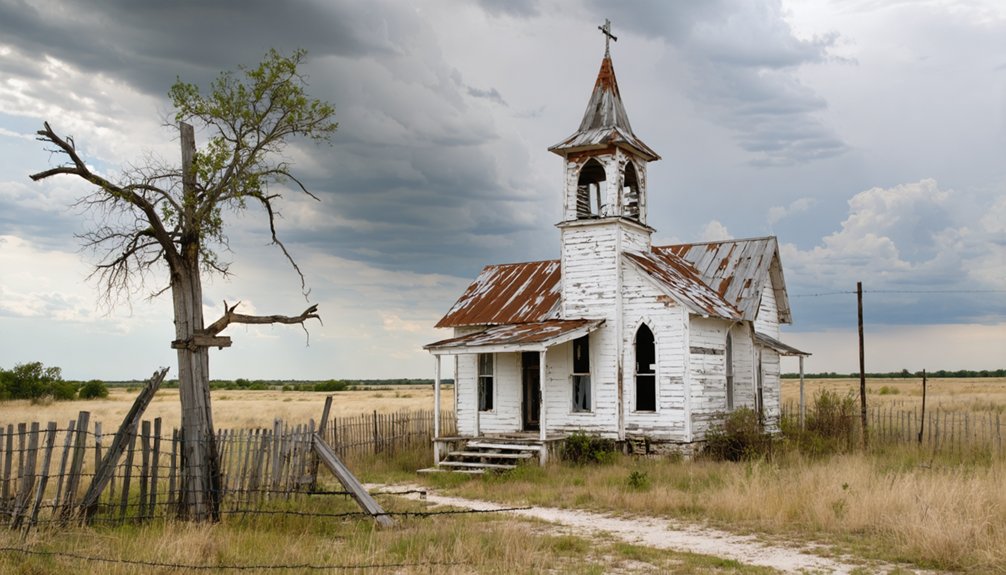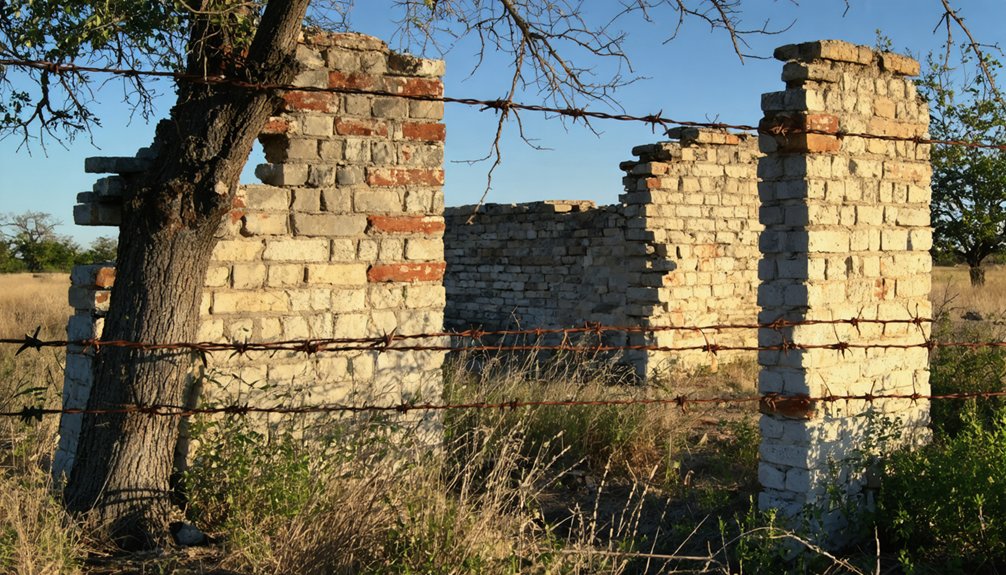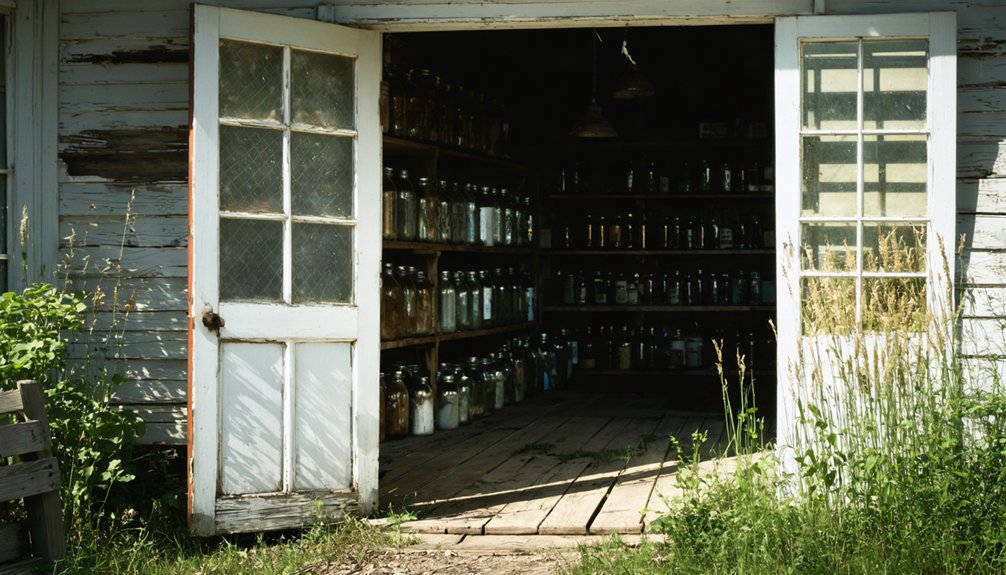You’ll find the remnants of Elizabethtown, Texas, fifteen miles southwest of Denton near I-35 and Highway 114. Originally nicknamed “Bugtown” after an insect-interrupted camp meeting, this 1850s Peters Colony settlement once thrived with six saloons, churches, and stores along Elizabeth Creek. The town declined after the Texas and Pacific Railway bypassed it in 1881. Today, only the historic Elizabeth Cemetery, with its 300 graves dating to the mid-1800s, marks this frontier town’s legacy.
Key Takeaways
- Elizabethtown became a ghost town after the Texas and Pacific Railway bypassed it in 1881, causing businesses and residents to relocate.
- Originally established around 1850, the town was a significant hub along Texas cattle trails before its decline.
- Elizabeth Cemetery is the only remaining physical landmark, containing about 300 graves dating back to the mid-1800s.
- The former town site, located near I-35 and Highway 114, is now occupied by an apartment complex.
- The town was nicknamed “Bugtown” due to an insect infestation that disrupted a preacher’s camp meeting.
The Origins of “Bugtown”
While Elizabethtown, Texas derived its official name from Elizabeth Creek, the town became widely known by its peculiar nickname “Bugtown” after a memorable incident at a preacher’s camp meeting in the mid-to-late 19th century.
During this gathering, hundreds of bugs swarmed the lights with such intensity that the meeting had to end early. The bug infestation proved so significant that it permanently affected the town’s regional reputation. The Peters Colony settlers established the community around 1850.
The nickname origin can be traced to residents of nearby Justin, Texas, who began using “Bugtown” in a somewhat mocking manner when referring to Elizabethtown. Though never officially adopted, the nickname stuck and became commonly used throughout neighboring communities, overshadowing the town’s proper name in local discourse. The area’s decline began when the Texas and Pacific Railway bypassed the settlement by two miles.
From Settlement to Frontier Hub
Established around 1850 by Peters Colony settlers, Elizabethtown rapidly evolved from a modest frontier settlement into an important hub along the cattle trails of northern Texas.
Despite early settlement challenges, you’ll find the town flourished along Elizabeth Creek, which provided essential water for both settlers and countless cattle drives passing through the region. Originally known as Bugtown, the settlement was later renamed to honor Elizabeth Minter. Today, visitors can explore the Elizabeth Cemetery which stands as a testament to the town’s rich history.
The community’s growth manifested through significant establishments that served both locals and travelers:
- Commercial ventures including general stores, a hotel, and six saloons
- Civic institutions like a post office, school, and multiple churches
- A Masonic lodge and livery stable that strengthened community bonds
Located fifteen miles southwest of Denton, Elizabethtown’s strategic position made it a key resupply point for pioneers and cattlemen traversing the Texas frontier, fueling its development as a self-sufficient settlement.
Daily Life in Early Elizabethtown
As daily life unfolded in early Elizabethtown, you’d find a bustling frontier community anchored by its six saloons, multiple churches, and essential institutions along Elizabeth Creek.
To avoid confusion with other similarly named settlements, local residents often specified their location as Elizabethtown, Texas.
You could pick up your mail at the post office, shop at one of several general stores, or stable your horse at the local livery.
Community gatherings centered around the Masonic lodge and church meetings, though the infamous “Bugtown” incident put a damper on outdoor religious assemblies.
You’d see about 25 children tackling educational challenges at the local schoolhouse, while cowboys passing through with their cattle herds brought fresh business to the hotel and merchants.
Baptist and Methodist congregations provided spiritual guidance, while the town’s strategic location made it a crucial supply stop for travelers heading north to Kansas. The town’s prosperity began to decline after the Texas and Pacific Railway bypassed the settlement in 1881.
The Railroad’s Decisive Impact
While Elizabethtown thrived as a cattle supply station with six saloons and multiple churches before 1881, the Texas and Pacific Railway‘s decision to bypass the town by two miles fundamentally altered its destiny.
You’ll find that Roanoke, the newly established railroad town to the east, quickly emerged as the preferred destination for businesses and residents seeking better transportation access.
The railway’s transformative influence led Elizabethtown’s merchants, social institutions, and families to relocate to Roanoke, effectively ending the older settlement’s economic viability.
Railroad Town Competition
The Texas and Pacific Railway‘s decision to bypass Elizabethtown by two miles in 1881 sealed the town’s fate, triggering a swift exodus of businesses and residents to the newly established railroad town of Roanoke.
During this era of rapid railroad expansion, you’d find towns fiercely competing for rail access, knowing it meant the difference between growth and economic decline. The high cost of wagon transport, at twenty cents per ton mile, made railroad connections essential for any town’s economic survival. Similar to the Kentucky experience during the Panic of 1837, financial instability could spell doom for towns without rail service.
When railway companies chose their routes, they prioritized efficient paths through major markets like Fort Worth and Denton, often leaving smaller settlements to wither.
- Towns without rail stations couldn’t compete in transporting cattle or goods
- Businesses relocated to rail-served communities for better transportation access
- Land speculation and railway charters favored specific locations, creating winners and losers in the race for survival
Life Before Rail Service
Before railroad tracks transformed Texas transportation, Elizabethtown thrived as a bustling frontier settlement near Elizabeth Creek in Denton County.
You’d find six saloons, a hotel, and various stores serving both locals and cattle drivers heading north to Kansas. While the town faced significant transportation challenges with unreliable dirt roads and no steamboat access, the community pulled together to build essential infrastructure.
You could attend services at Baptist or Methodist churches, send your children to the local school, or participate in Masonic lodge activities.
Despite the limitations of ox carts and wagon trails for moving goods, Elizabethtown’s position as a strategic resupply point for cattle drives helped sustain its economy before railroad alternatives reshaped regional commerce.
Notable Buildings and Landmarks

Today when you visit Elizabethtown, you’ll find Elizabeth Cemetery stands as the town’s most prominent remaining landmark, preserving the memory of pioneer settlers and their families.
The town once boasted multiple commercial buildings, including a Masonic lodge, several general stores, a hotel, and six saloons that served the frontier community. Modern visitors should note that the area is marked by a sign warning of a bridge out condition.
While most structures have vanished, historical records tell us that these buildings formed a bustling hub of commerce and social activity during the town’s peak in the mid-19th century.
Historical Commercial Structures
During its peak in the mid-19th century, Elizabethtown boasted a diverse collection of commercial establishments that served both local residents and passing cattle drivers. The town’s commercial legacy included crucial businesses like general stores, a hotel, and at least six saloons.
You would’ve found a bustling livery stable supporting travelers and traders, alongside a post office that kept the community connected.
Key commercial features that defined Elizabethtown’s frontier character:
- Multiple general stores that supplied essential goods to settlers and travelers
- A prominent Masonic lodge that served as a social and fraternal hub
- Community service buildings including schools and churches built by the Harmonson family
Today, these architectural remnants have vanished, with only the Elizabeth Cemetery marking the town’s original location.
Elizabeth Cemetery Remains
The Elizabeth Cemetery stands as the last physical remnant of Elizabethtown’s frontier legacy, situated southeast of Elizabeth Creek near the intersection of Interstate 35 and State Highway 114 in Denton County.
You’ll find this 1.5-acre historical site surrounded by modern warehouses and residential developments, yet it maintains its cultural significance through active cemetery preservation efforts.
The grounds contain about 300 identified graves, with the earliest burials dating to the mid-1800s.
William Perry Harmonson donated the land following his mother’s death around 1867, establishing its historical significance as the final resting place for multiple generations of pioneer families.
Today, while the ghost town has vanished, the cemetery continues to serve as an essential landmark, protected by local historical societies and descendants who guarantee its heritage endures.
In 1949, the cemetery grounds were expanded to two acres using adjacent former school property.
The Elizabeth Cemetery Legacy
Standing as the primary surviving landmark of Elizabethtown, Texas, Elizabeth Cemetery chronicles the rich history of this former frontier settlement through its approximately 300 identified graves.
You’ll find this historical treasure south of Highway 114 and east of Interstate 35, where it preserves the legacy of pioneer families and the town’s vibrant past. The cemetery’s significance extends beyond its role as a burial ground, serving as an essential link to the region’s frontier heritage.
- Multiple generations of the Harmonson family, the town’s founding settlers, rest here
- The 1978 historical marker commemorates both the cemetery and Elizabethtown’s legacy
- The site continues to serve as an active burial ground, maintaining its connection to modern times
Today, you can explore this living representation of Elizabethtown’s transformation from a bustling cattle supply station to a cherished historical site.
Modern Day Remnants

Beyond Elizabeth Cemetery‘s historical grounds, modern-day Elizabethtown presents a stark contrast to its once-bustling frontier atmosphere.
You’ll find few traces of the original settlement, as an apartment complex now occupies the former town center. Located about fifteen miles southwest of Denton, near the intersection of I-35 and Highway 114, the area’s transformation is nearly complete.
For ghost town exploration enthusiasts, the primary destination remains Elizabeth Cemetery, accessed via Elizabethtown Cemetery Road.
While the cemetery hosts roughly 300 identified graves and continues to serve the community, the surrounding landscape has surrendered to nature.
You won’t find any original structures standing – the town’s physical remnants disappeared after the Texas and Pacific Railway bypassed it, leaving only the cemetery to tell its story.
Tales of Pioneer Resilience
Through countless trials and tribulations, Elizabethtown’s pioneer settlers demonstrated remarkable resilience during their mid-19th century frontier experience.
The pioneer stories of this Texas settlement reveal how the community’s strength helped them overcome significant challenges while building their frontier home along Elizabeth Creek.
- When Native American resistance threatened settler safety, families banded together to protect their developing township.
- After many residents fled east during the Civil War, they returned with determination to rebuild their churches, schools, and businesses.
- Despite the infamous insect swarm that earned them the “Bugtown” nickname, settlers maintained their resolve and continued holding camp meetings and social gatherings.
You’ll find their spirit of perseverance echoed through the institutions they maintained until the railway’s bypass forced their relocation to Roanoke.
Frequently Asked Questions
What Indigenous Tribes Lived in the Elizabethtown Area Before Settlers Arrived?
You’d find the Caddo, Comanche, and Tonkawa peoples shaped indigenous history near your area, while Cherokee, Alabama, and Coushatta tribes briefly passed through, contributing to the region’s rich tribal culture.
How Many People Lived in Elizabethtown During Its Peak Population?
While other Texas boom towns saw massive growth, you’ll find Elizabethtown’s town demographics peaked at just 130 residents in 1884, during its strongest peak economy phase with mills, schools, and churches operating.
Were There Any Famous Gunfights or Notable Crimes in Elizabethtown?
You won’t find records of famous gunfights in this location, though regional gunfights history and notorious criminals like Clay Allison shaped nearby areas through violent vigilante justice during the lawless frontier period.
What Happened to the Original Harmonson Family After the Town’s Decline?
You’ll find many Harmonson descendants adapted by moving to nearby communities like Roanoke and Denton County, where they maintained their family legacy through continued civic involvement and local government participation.
Did Any Valuable Artifacts From Elizabethtown Survive to Modern Times?
You’ll find surviving artifacts mostly consist of coal mining relics like miner tags and bottles, which hold significant historical value despite lacking precious metals. These preserved items offer tangible connections to frontier life.
References
- https://christmasair.com/elizabethtown-tx/
- https://dentoncountyhistoryandculture.wordpress.com/2019/04/05/dissipated-towns-of-denton-county-elizabethtown-drop-and-stony/
- https://en.wikipedia.org/wiki/Elizabethtown
- https://www.newmexico.org/places-to-visit/ghost-towns/
- https://kids.kiddle.co/Elizabethtown
- https://www.ghosttowns.com/states/tx/elizabethtown.html
- https://www.texasescapes.com/CentralTexasTownsNorth/Elizabethtown-Texas.htm
- https://www.securedmoving.com/post/elizabethtown-a-texas-ghost-town-thats-still-hauntingly-beautiful
- https://www.hilltoptx.com/elizabethtown-tx/
- https://www.justintexashistory.com/NearbyTownHistories.html



